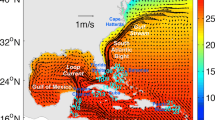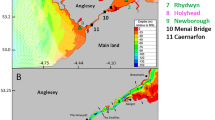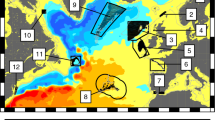Abstract
Large aggregations of adult permit (Trachinotus falcatus) were consistently observed since 2004 by divers in a collaborative fishery-independent reef fish visual census survey during May and June on the western-most edge of the Dry Tortugas Bank, Florida, in coral reef habitat, indicating proximal spawning sites. We investigated the possible fate and connectivity of larvae spawned at this location in the Dry Tortugas and two other published aggregation sites through a drift analysis using the ocean circulation and transport dynamics simulator HYCOM (Hybrid Community Ocean Model). New age-length data facilitated the determination of larval durations and rates of juvenile growth. Modeled larval transport data from spawning sites in the Dry Tortugas, Belize and Cuba were evaluated and compared to a spatially-extensive empirical juvenile permit data set from Florida. Our study revealed that unique oceanographic processes provided pathways for both downstream larval transport and juvenile retention, to and from Florida waters. These simulation results indicated that the Dry Tortugas region is a key source of permit recruits to southeast Florida stretching from the Florida Keys and up Florida’s east coast, and to a much lesser extent the west Florida shelf. Simulations from Belize and Cuba spawning sites revealed high local retention with low connectivity to Florida, emphasizing the importance of local resource management throughout the permit’s range.










Similar content being viewed by others
References
Adams AJ, Blewett DA (2004) Spatial patterns of estuarine habitat use and temporal patterns in abundance of juvenile permit, (Trachinotus falcatus). Gulf and Carib Res 16:129–139
Adams AJ, Wolfe RK, Kellison GT, Victor BC (2006) Patterns of juvenile habitat use and seasonality of settlement by permit, Trachinotus falcatus. Environ Biol Fish 75:209–217
Armstrong MP, Hood PB, Murphy MD, Muller RG (1996) A stock assessment of permit, Trachinotus falcatus, in Florida waters. FL DEP FMRI IHR 1996-005:50
Ault JS, Bohnsack JA, Meester GA (1998) A retrospective (1979–1996) multispecies assessment of coral reef fish stocks in the Florida Keys. Fish Bull 96:395–414
Ault JS, Bohnsack JA, Smith SG, Luo J (2005) Towards sustainable multispecies fisheries in the Florida USA coral reef ecosystem. Bull Mar Sci 76:595–622
Ault JS, Smith SG, Bohnsack JA, Luo J, Harper DE, McClellan DB (2006) Building sustainable fisheries in Florida’s coral reef ecosystem: positive signs in the Dry Tortugas. Bull Mar Sci 78:633–654
Ault JS, Smith SG, Bohnsack JA, Luo J, Zurcher N, McClellan DB, Ziegler TA, Hallac DE, Patterson ME, Feeley MW, Ruttenburg BI, Hunt J, Kimball D, Causey B (2013) Assessing coral reef fish changes and marine reserve dynamics in the Dry Tortugas, Florida USA. Fish Res 144:28–37
Ault JS, Smith SG, Browder JA, Nuttle W, Franklin EC, Luo J, DiNardo GT, Bohnsack JA (2014) Indicators for assessing the ecological and sustainability dynamics of southern Florida’s coral reef and coastal fisheries. Ecol Indic 44:164–172
Bakun A (1996) Patterns in the ocean: ocean processes and marine population dynamics. Monterey, California Sea Grant College System and NOAA
Beverton RJH, Holt SJ (1957) On the dynamics of exploited fish populations. Fishery Investigations Series II, vol. 19. Ministry of Agriculture, Fisheries and Food, Lowestoft, UK
Bohnsack JA, Ault JS (1996) Management strategies to conserve marine biodiversity. Oceanography 9:73–82
Botsford LW, Brumbaugh DR, Grimes C, Kellner JB, Largier J, O’Farrell MR, Ralston S, Soulanille E, Wespestad V (2009) Connectivity, sustainability, and yield: bridging the gap between conventional fisheries management and marine protected areas. Rev. Fish Bio. Fish. 19:69–95
Brandt ME, Zurcher N, Acosta A, Ault JS, Bohnsack JA, Feeley MW, Harper DE, Hunt J, Kellison GT, McClellan DB, Patterson ME, Smith SG (2009) A cooperative multi-agency reef fish monitoring protocol for the Florida Keys coral reef ecosystem. Natural Resource Report NPS/SFCN/NRR—2009/150. National Park Service, Fort Collins, Colorado
Burton ML, Brennan KJ, Muñoz RC, Parker RO Jr (2005) Preliminary evidence of increased spawning aggregations of mutton snapper (Lutjanus analis) at Riley’s Hump two years after establishment of the Tortugas south ecological reserve. Fish Bull 103:404–410
Caley MJ, Carr MH, Hixon MA, Hughes TP, Jones GP, Menge BA (1996) Recruitment and the local dynamics of open marine populations. Annu Rev Ecol Syst 27:477–500
Chassignet EP, Hurlburt HE, Smedstad OM, Halliwell GR, Hogan PJ, Wallcraft AJ, Baraille R, Bleck R (2007) The HYCOM (Hybrid Coordinate Ocean Model) data assimilative system. J Mar Syst 65:60–83
Cowen RK, Sponaugle S (2009) Larval dispersal and marine population connectivity. Annu Rev Mar Sci 1:443–466
Cowen RK, Lwiza KMM, Sponaugle S, Paris CB, Olson DB (2000) Connectivity of marine populations: open or closed? Science 287:857–859
Crabtree RE, Hood PB, Snodgrass D (2002) Age, growth, and reproduction of permit (Trachinotus falcatus) in Florida waters. Fish Bull 100:26–34
Cummings JA (2005) Operational multivariate ocean data assimilation. Quart J Royal Met Soc 131:3583–3604
Dahlgren CP, Sobel J (2000) Designing a Dry Tortugas ecological reserve: how big is big enough?... To do what? Bull Mar Sci 66:707–719
Davis GE (1982) A century of natural change in coral distribution at the Dry Tortugas: a comparison of reef maps from 1881 and 1976. Bull Mar Sci 32:608–623
Domeier ML (2004) A potential larval recruitment pathway originating from a Florida marine protected area. Fish Oceanogr 13:287–294
Domeier ML, Colin PL (1997) Tropical reef fish spawning aggregations: defined and reviewed. Bull Mar Sci 60:698–726
Félix FC, Spach HL, Moro PS, Schwarz R, Santos C, Hackradt CW, Hostim-Silva M (2007) Utilization patterns of surf zone inhabiting fish from beaches in Southern Brazil. Panam J Aquat Sci 2:27–39
Fields HM (1962) Pompanos (Trachinotus spp.) of south Atlantic coast of the United States. Fish Bull 62:89–222
Franklin EC, Ault JS, Smith SG, Luo J, Meester GA, Diaz GA, Chiappone M, Swanson DW, Miller SL, Bohnsack JA (2003) Benthic habitat mapping in the Tortugas region, Florida. Mar Geo 26:19–34
Fratanoni PS, Lee TN, Podesta GP, Muller-Karger FE (1998) The influence of loop current perturbations on the formation and evolution of Tortugas eddies in the southern straits of Florida. J. Geo. Res. 103:24759–24779
García-Cagide A, Claro R, Koshelev BV (2001) Reproductive patterns of fishes of the Cuban shelf. In: Claro R, Lindeman KC, Parenti LR (eds) Ecology of the marine fishes of Cuba. Smithsonian Institution Press, Washington DC, pp. 73–114
Graham RT, Castellanos DW (2005) Courtship and spawning behaviors of carangid species in Belize. Fish Bull 103:426–432
Heyman DH, Kjerfve B (2008) Characterization of transient multi-species reef fish spawning aggregations at Gladden Spit. Belize Bull Mar Sci 83:531–551
IGFA (2015) IGFA world record game fishes: freshwater, saltwater and flyfishing. International Game Fish Association, Dania Beach, Florida
Jones GP, Almany GR, Russ GR, Sale PF, Steneck RS, van Oppen MJH, Willis BL (2009) Larval retention and connectivity among populations of corals and reef fishes: history, advances and challenges. Coral Reefs 28:307–325
Jory DE (1986) An incident of predation on queen conch, Strombus gigas L. (mullusca, strombidae), by Atlantic permit, Trachinotus falcatus L. (Pisces, carangidae). J Fish Biol 28:129–131
Karnauskas M, Chérubin LM, Paris CB (2011) Adaptive significance of the formation of multi-species fish spawning aggregations near submerged caps. PLoS ONE 6: e22067
Lee TN, Williams E (1999) Mean distribution and seasonal variability of coastal currents and temperature in the Florida Keys with implications for larval recruitment. Bull Mar Sci 64:35–56
Lee TN, Rooth C, Williams E, McGowan M, Szmant AF, Clarke ME (1992) Influence of Florida current, gyres and wind-driven circulation on transport of larvae and recruitment in the Florida Keys coral reefs. Cont Shelf Res 12:971–1002
Lee TN, Clarke ME, Williams E, Szmant AF, Berger T (1994) Evolution of the Tortugas gyre and its influence on recruitment in the Florida Keys. Bull Mar Sci 54:621–646
Levin LA (2006) Recent progress in understanding larval dispersal: new directions and digressions. Integr Comp Biol 46:282–297
Lindeman KC, Pugliese R, Waugh GT, Ault JS (2000) Developmental pathways within a multispecies reef fishery: management applications for essential fish habitats and protected areas. Bull Mar Sci 66:929–956
Mann KH, Lazier JRN (2005) Dynamics of marine ecosystems: biological-physical interactions in the ocean, 3rd edn. Blackwell Publishing, London
Meester GA, Mehrotra A, Ault JS, Baker EK (2004) Designing marine reserves for fishery management. Manag Sci 50:1031–1043
Mullin MM (1993) Webs and scales: physical and ecological processes in marine fish recruitment. Books in recruitment fishery oceanography. Washington Sea Grant Program, Seattle
Olson DB (2001) Biophysical dynamics of western transition zones: a preliminary synthesis. Fish Oceanogr 10:133–150
Paris CB, Cowen RK, Claro R, Lindeman KC (2005) Larval transport pathways from Cuban snapper (lutjanidae) spawning aggregations based on biophysical modeling. Mar Ecol Prog Ser 296:93–106
Robins CR, Ray GC, Douglas J (1986) A field guide to Atlantic coast fishes. The Peterson Field Guide Series. Houghton Mifflin Co., Boston
Rothschild BJ (1986) Dynamics of marine fish populations. Harvard University Press, Cambridge
Sammarco PW, Heron ML, eds (1994) The bio-physics of marine larval dispersal. Coastal and Estuarine Studies 45. American Geophyscal Union. Washington, DC.
Secor DH, Dean JM (1992) Comparison of otolith-based back-calculation methods to determine individual growth histories of larval striped bass, Morone saxatilis. Can J Fish Aquat Sci 49:1439–1454
Smith SG, Ault JS, Bohnsack JA, Harper DE, Luo J, McClellan DB (2011) Multispecies survey design for assessing reef-fish stocks, spatially-explicit management performance, and ecosystem condition. Fish Res 109:25–41
Smith-Vaniz WF (2002) Carangidae. In: Carpenter KE (ed) The living marine resources of the western central Atlantic. Volume 3: Bony fishes part 2 (Opistognathidae to Molidae), sea turtles and marine mammals. FAO, Rome, pp 1426–1468
Snodgrass D, Harnden CW (2009) Composition of fish species on ocean-side beach habitats in the Florida Keys. Fl Sci 72:153–170
Sponaugle S, Lee T, Kourafalou V, Pinkard D (2005) Florida current frontal eddies and the settlement of coral reef fishes. Limnol Oceanogr 50:1033–1048
Stommel H (1976) The Gulf Stream: a physical and dynamical description, 2nd edn. University of California Press, Berkeley
Acknowledgments
We thank Natalia Zurcher and Nick Farmer for their assistance with empirical field efforts; Tracy Ziegler, Dave Hallac and Dan Kimball of NPS for coordinating research in the Dry Tortugas; Bob McMichaels of FWC for directing the Florida Fisheries Independent Monitoring Program (FIM) Program; and the numerous biologists for their herculean statewide FIM beach seining efforts. Initial funding was provided by Dry Tortugas National Park through CESU Grant No. H5000065040-J5299-06-1017 as part of an integrated science program to study the efficacy of marine reserves in the region. Additional funding was provided by the NOAA Coral Reef Conservation Program, NOAA National Marine Fisheries Service, Florida Keys National Marine Sanctuary, Florida Fish and Wildlife Conservation Commission, Robertson Foundation, and the Tarpon & Bonefish Research Center at the University of Miami. This research was approved by the Institutional Animal Care and Use Committee (IACUC) at the University of Miami.
Author information
Authors and Affiliations
Corresponding author
Rights and permissions
About this article
Cite this article
Bryan, D.R., Luo, J., Ault, J.S. et al. Transport and connectivity modeling of larval permit from an observed spawning aggregation in the Dry Tortugas, Florida. Environ Biol Fish 98, 2263–2276 (2015). https://doi.org/10.1007/s10641-015-0445-x
Received:
Accepted:
Published:
Issue Date:
DOI: https://doi.org/10.1007/s10641-015-0445-x




